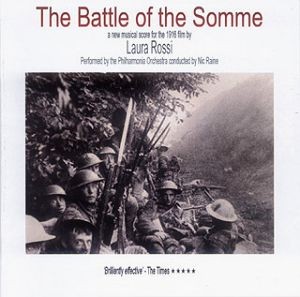 ‘And these troops in the mud grinned or stared at us to a new music score by Laura Rossi, brilliantly effective, played with typical dexterity and polish by the Philharmonia Orchestra under the conductor Nic Raine. Whatever piercing image you might pick — the troops’ cheerful waves, the mascot dog dead with its master, the trench channel’s mud and corpses — Rossi’s score and the IWM’s new print will help them to reverberate even further into the future.’
‘And these troops in the mud grinned or stared at us to a new music score by Laura Rossi, brilliantly effective, played with typical dexterity and polish by the Philharmonia Orchestra under the conductor Nic Raine. Whatever piercing image you might pick — the troops’ cheerful waves, the mascot dog dead with its master, the trench channel’s mud and corpses — Rossi’s score and the IWM’s new print will help them to reverberate even further into the future.’
Geoff Brown, The Times ![]() – [read full review]
– [read full review]
‘You cannot deny the power of this score; Laura Rossi very adeptly creates an emotional picture through impressive orchestral writing which is at once colourful, honourable, celebratory and moving. The performance by the Philharmonia Orchestra, under Nic Raine, is pristine and the CD package hugely interesting as it features extracts from the diary of a stretcher-bearer from the 29th Division – Fred Ainge, Laura Rossi’s Great Uncle. The Battle of the Somme is a fine memorial of music, for a point in history that should never be forgotten.’
Michael Beek – Music from the Movies
‘A thoughtful, elegiac work which wonderfully matched the images.’
Jerome Kuehl – History Today.
‘Rossi supplies a rich, subtle and binding score that connects 2008 to 1916.’
Luke McKernan, The Bioscope
‘Rossi’s masterful knowledge of orchestration is evident from the very start of the CD, never allowing for a dull moment in the music. Her orchestrations are on par with those of the great Hollywood composers. This is a truly breathtaking score that will positively influence other young composers. Incredibly well written and performed, Rossi’s score for The Battle of the Somme was among the best of 2008.’
Oscar Flores, Filmmusicsite.com
‘A work of emotional depth and beauty… Laura’s music, recorded by the Philharmonia Orchestra and conducted by Nic Raine, reflects the event’s heroism with superlative accuracy… A truly important piece’
Keith Ames, Musician Magazine
‘a hugely impressive piece of work’
Gary Dalkin, MusicWeb International
‘an admirable accompaniment to this monumental film’
Jeff Hall, Screen Sounds
The Times ![]()
October 25, 2006
The Battle of the Somme
Geoff Brown at Queen Elizabeth Hall
‘Ninety years later, what has etched the slaughter of the battle of the Somme into the British memory? A few hideous facts have helped: the 19,240 British dead on the first day; an overall casualty figure of more than one million.
But more than anything it is the work of a film: The Battle of the Somme, photographed on the spot in 1916, planned as British war-boosting propaganda, yet containing in its schizophrenic jumble painful shots of the dead, near dead and bandaged remnants.
At the time almost half the British population saw the Somme film in cinemas, many seeking evidence of loved ones; and there has scarcely been a First World War documentary that hasn’t plundered its images.
On Sunday night this extraordinary film reached two new milestones. One was a certificate marking its entry into Unesco’s registry of documentary artefacts, Memory of the World — the first film, and British item, to make the grade.
The second milestone was the Imperial War Museum’s new presentation of its archive treasure. Many shots had previously looked bleached; digital restoration brought the detail back. And these troops in the mud grinned or stared at us to a new music score by Laura Rossi, brilliantly effective, played with typical dexterity and polish by the Philharmonia Orchestra under the conductor Nic Raine.
Inevitably the music was coloured by hindsight. Though brass rang out in the finale, there was no simple patriotic toot-tooting. We approached the gates of pathos, but avoided mawkish sentiment. Sombre introspection ruled.
Hovering strings surveyed the pre-battle landscape. A wind machine’s eerie gale triggered the first attack. Stretcher cases returned to a plangent oboe (Rossi’s grandfather had been a bearer). The guns’ bombardments prompted synchronised timpani rolls and shivers from the piano’s plucked strings or lower keys. Nothing was overdone here; nothing screamed.
In this music, quite correctly, we heard courage and futility. And plenty of tension: a tremendous help in carrying us through a film flung together in the heat of the moment, never recollected in tranquillity.
Whatever piercing image you might pick — the troops’ cheerful waves, the mascot dog dead with its master, the trench channel’s mud and corpses — Rossi’s score and the IWM’s new print will help them to reverberate even further into the future.’